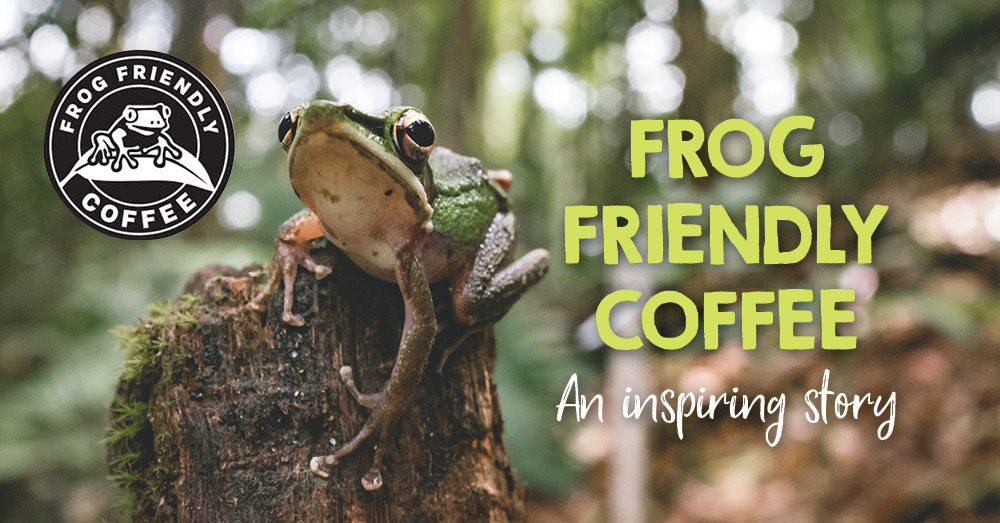
Loading..
My Store
Hours of Operation
Find your nearest store
Results
Loading...

"We love our local suppliers who put as much care into quality and sustainability as we do—like Salmon Arm-based Frog Friendly Coffee which we’re proud to pour in our Bistros. We recently spent time with founder Karla Ferster to learn about their delicious, wild-grown coffee beans."
I grew up in South Surrey and my family spent a lot of time travelling in Mexico. We grew roots in Oaxaca, where we connected with a wonderful Mexican family. Two of the brothers, Pedro and Juan, spent a lot of time in Canada with us when we were teenagers.
Pedro and I shared a passion for the mountains and always talked about doing something to protect the wild spaces and their biodiversity. One day, he called to say he’d figured it out when an old man showed him a branch of wild coffee cherries. I went to see where they grew, in the last remaining intact cloud forest of Mexico, with old growth stands of Mexican pine, mahogany, cinnamon, and wild cacao. The air smells like a flower shop: moist, rich, and alive—a rock concert of life. There’s no silence because it’s so biologically alive.
We both knew this was what we’d been looking for, so I took the deepest breath of my life, bought a 78-hectare finca (estate) with Pedro, and the results have been awesome.
Today, we harvest our own coffee and buy from local families to reach our quotas. The fresh, green beans are brought here to roast, in the eco-friendliest roaster on the market. We compost the coffee mulch, and our packaging is made of 100% recyclable materials.
Science shows that the more biodiverse the environment, the richer the coffee. Because our growing environment is wild, our coffee is off-the-charts full of antioxidants and minerals, and has low acidity. When customers with stomach problems told us they didn’t experience any pain when drinking our coffee, we had it tested in a lab. It’s now recognized as being the healthiest for people with Crohn’s disease, colitis, and IBS, and is the only coffee recommended by the accredited nutrition college in Vancouver.
It’s not. Commercial coffees that are intensely grown, in the sun, have the highest acidity. Many companies say they are shade grown—like those with Rainforest Certification—but up to 60% can be artificial shade. And while Fair Trade guarantees a minimum price paid to a co-op head or landowner, how they pay the people harvesting the most labour-intensive crop in the world is at their discretion.
Our coffee grows wild and is self-seeded, without chemical sprays or pesticides. Every aspect of production is geared to ethical, sustainable practices; we even transport the coffee on foot and by mule Hanging out in La Chao 16 years ago with some of the local kids who pick cacao. Semitrio, the keeper of the forest. He supported us for the first eight years with his knowledge and relationships. We miss him. 16 | November/December 2019 to preserve the surrounding wildlife. No hunting is allowed on our land to preserve wildlife like endangered pink armadillo, miniature deer, ocelot, and bear.
We’re the only coffee company that has passed a third-party audit to prove it is truly wild.
It’s so hard! I admire and appreciate Pedro’s incredible fortitude and passion to adapt and biodynamically fight the challenges of a weakening environment driven by global warming, rust (an airborne fungus that attacks coffee trees), and a worm that kills trees when they bore in to lay larvae.
Coffee prices are low now, which has an incredible impact on people in these communities. Because people live hand to mouth, desperate to feed their families, they’re burning beautiful forest plantations for cattle. They don’t have the education to understand that land for cattle is only good for three or four years, because when the soil has blown away, all the nutrition will be gone.
We operate outside the commodities markets and set our own prices to pay premium wages for our workers, and I want to make it a priority to focus on reforestation. The greatest power lies with consumers and their buying choices. Everyone can do something by paying a little extra for better quality.
We’re introducing a 2 lb bag next spring, and hope to introduce wild vanilla, chocolate, and cinnamon. Our greatest goal is to be an example of a true, sustainable forest harvesting native coffee. It’s an absolute commitment to the highest quality.
{"one"=>"Select 2 or 3 items to compare", "other"=>"{{ count }} of 3 items selected"}
Leave a comment